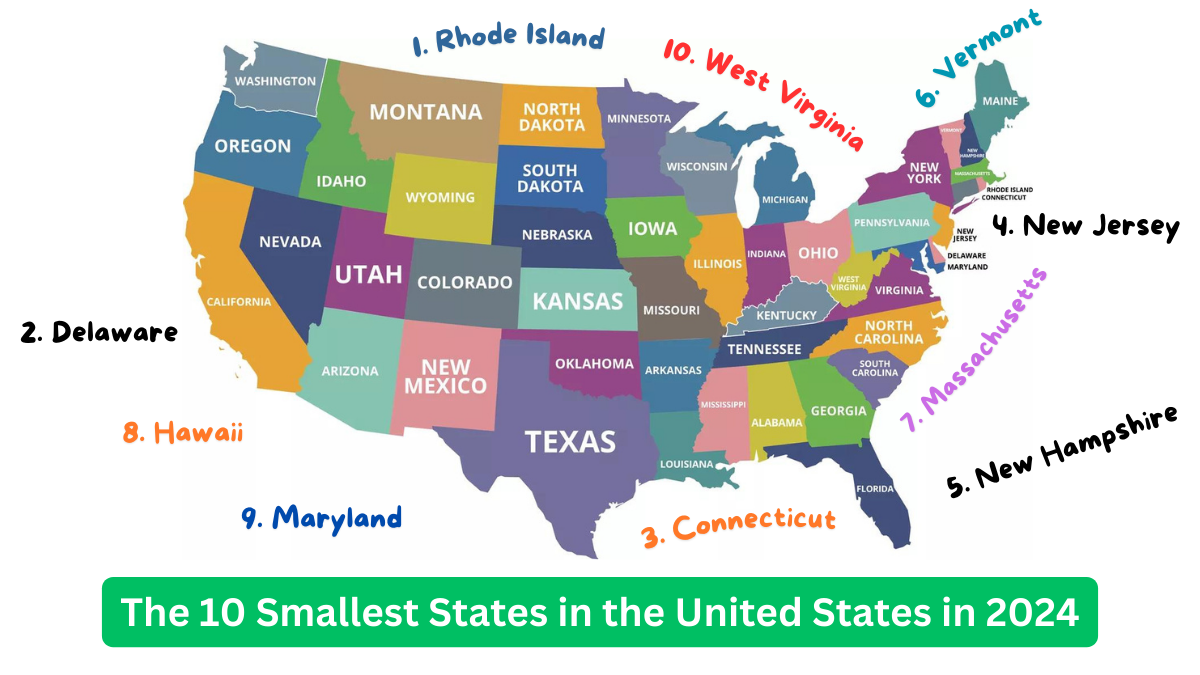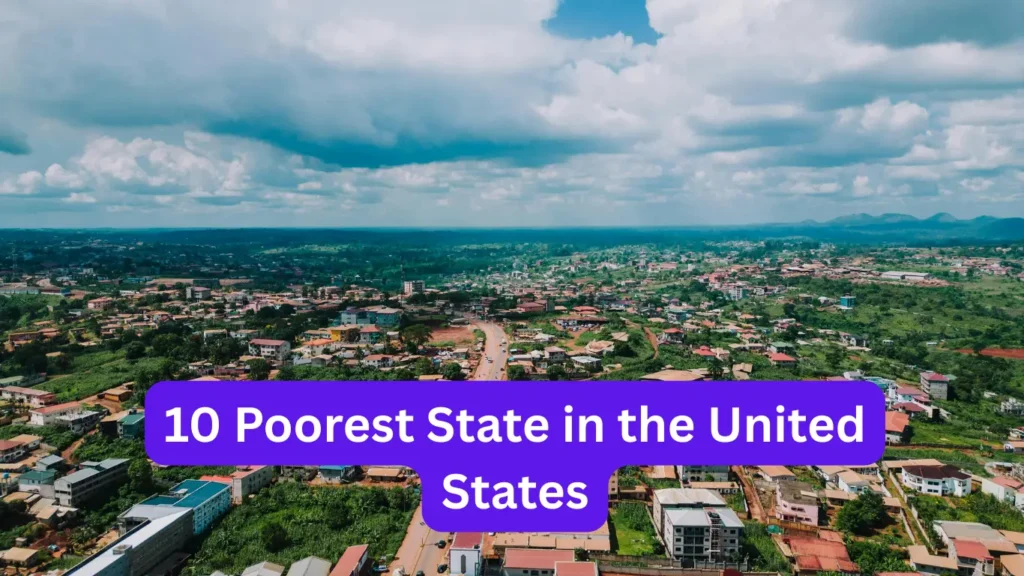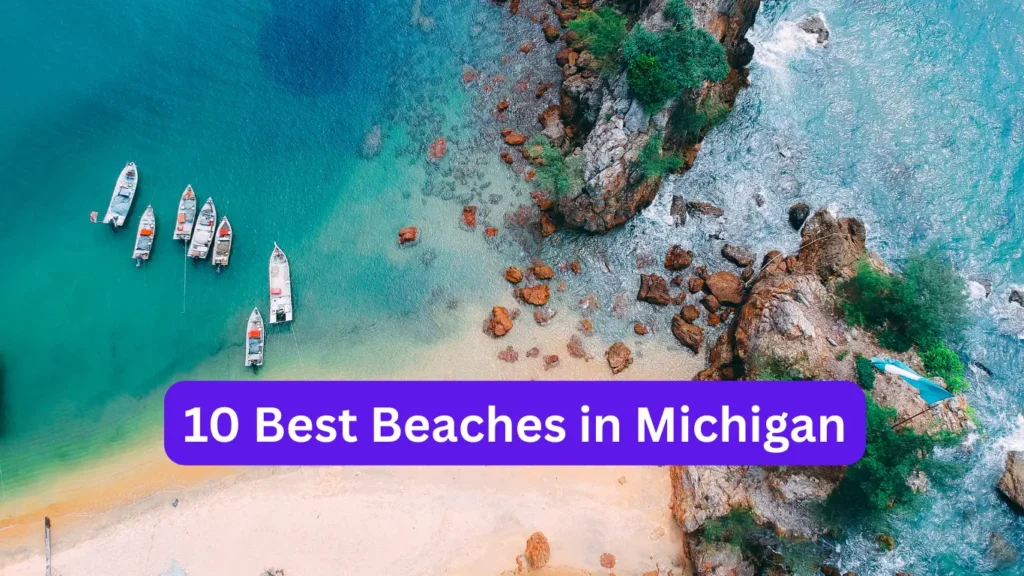Rhode Island is the smallest state in the United States, covering just 1,214 square miles (3,144 km²). Among the 50 states, it is over 400 times smaller than Alaska, the largest state.
The United States, with a total area of roughly 3.8 million square miles (9.8 million km²), ranks as the third-largest country globally by land area, following only Russia and Canada. The U.S., made up of 50 states, began its journey in 1776 with the original 13 colonies. The expansion of statehood reached its completion in 1959 with Hawaii becoming the 50th state.
The 10 Smallest States in the United States in 2024
Here is a list of the top 10 Smallest States in the United States as of 2024, including their total surface areas, land areas, water areas, and the percentage of water.
10. West Virginia
- Total Area: 24,230 sq mi (62,756 km²)
- Land Area: 24,038 sq mi (62,259 km²)
- Water Area: 192 sq mi (497 km²)
- Percentage of Water: 0.8%
West Virginia is the only state formed by seceding from a Confederate state during the Civil War. It was admitted to the Union on June 20, 1863.
West Virginia, known for its mountainous terrain and rich history, covers a total area of 24,230 square miles (62,756 km²). Of this, 24,038 square miles (62,259 km²) is land, while 192 square miles (497 km²) is water. Water bodies make up only 0.8% of the state’s total area.
Historical Background: The state’s rugged terrain and abundant natural resources, particularly coal, have shaped its history. The mining industry, along with timber and manufacturing, has been central to West Virginia’s economy.
9. Maryland
- Total Area: 12,406 sq mi (32,131 km²)
- Land Area: 9,707 sq mi (25,142 km²)
- Water Area: 2,699 sq mi (6,990 km²)
- Percentage of Water: 21.8%
Maryland, a state rich in historical significance and diverse landscapes, has a total area of 12,406 square miles (32,131 km²). Of this, 9,707 square miles (25,142 km²) is land, and 2,699 square miles (6,990 km²) is water. Water bodies make up 21.8% of the state’s total area.
Maryland is known as “America in Miniature” because it has a bit of everything—mountains, farmland, beaches, and cities.
Historical Background: As one of the original Thirteen Colonies, Maryland played a significant role in the early history of the United States. It was a key battleground during the Civil War and is home to the nation’s capital, Washington, D.C., which was established on land donated by Maryland.
8. Hawaii
- Total Area: 10,932 sq mi (28,313 km²)
- Land Area: 6,423 sq mi (16,635 km²)
- Water Area: 4,509 sq mi (11,678 km²)
- Percentage of Water: 41.2%
Hawaii is the only U.S. state composed entirely of islands and is the most isolated population center on Earth.
Historical Background: Hawaii was an independent kingdom until it was overthrown in 1893. It became a U.S. territory in 1898 and was admitted as the 50th state in 1959. The state’s economy is heavily dependent on tourism, agriculture, and the military.
7. Massachusetts
- Total Area: 10,554 sq mi (27,336 km²)
- Land Area: 7,800 sq mi (20,202 km²)
- Water Area: 2,754 sq mi (7,134 km²)
- Percentage of Water: 26.1%
Massachusetts, a state steeped in American history and home to vibrant cities and coastal regions, encompasses a total area of 10,554 square miles (27,336 km²). Of this, 7,800 square miles (20,202 km²) is land, and 2,754 square miles (7,134 km²) is water. Water bodies make up a significant 26.1% of the state’s total area.
Massachusetts is home to Harvard University, the oldest institution of higher learning in the United States, established in 1636.
Historical Background: As a key state in the American Revolution, Massachusetts is rich in colonial history. The Boston Tea Party, the Battles of Lexington and Concord, and other pivotal events in American history occurred here. The state has a diverse economy, with education, healthcare, technology, and finance playing major roles.
6. Vermont
- Total Area: 9,616 sq mi (24,906 km²)
- Land Area: 9,217 sq mi (23,871 km²)
- Water Area: 400 sq mi (1,035 km²)
- Percentage of Water: 4.2%
Vermont, a state renowned for its picturesque landscapes and vibrant autumn foliage, covers a total area of 9,616 square miles (24,906 km²). Of this, 9,217 square miles (23,871 km²) is land, while 400 square miles (1,035 km²) is water. Water bodies constitute 4.2% of the state’s total area.
Vermont is the leading producer of maple syrup in the United States, contributing about 47% of the country’s supply.
Historical Background: Vermont was originally an independent republic before joining the United States in 1791 as the 14th state. Known for its small towns, scenic landscapes, and outdoor activities, Vermont has a strong tradition of progressive politics and environmental stewardship.
5. New Hampshire
- Total Area: 9,349 sq mi (24,214 km²)
- Land Area: 8,953 sq mi (23,187 km²)
- Water Area: 397 sq mi (1,027 km²)
- Percentage of Water: 4.2%
New Hampshire, a state known for its natural beauty and mountainous landscapes, spans a total area of 9,349 square miles (24,214 km²). Of this, 8,953 square miles (23,187 km²) is land, and 397 square miles (1,027 km²) is water. Water bodies make up 4.2% of the state’s total area.
New Hampshire is known for its “Live Free or Die” motto and its early primary in the U.S. presidential election cycle.
Historical Background: New Hampshire was one of the original Thirteen Colonies and played a vital role in the American Revolution. Its economy has evolved from traditional industries such as textiles and paper to include technology, healthcare, and education.
4. New Jersey
- Total Area: 8,723 sq mi (22,591 km²)
- Land Area: 7,354 sq mi (19,047 km²)
- Water Area: 1,368 sq mi (3,544 km²)
- Percentage of Water: 15.7%
New Jersey has the highest population density of any U.S. state, despite being one of the smallest in area.
Historical Background: New Jersey was pivotal during the American Revolution, with many key battles fought on its soil. Today, it is a major industrial, commercial, and financial hub, with strong sectors in pharmaceuticals, finance, and telecommunications.
3. Connecticut
- Total Area: 5,543 sq mi (14,357 km²)
- Land Area: 4,842 sq mi (12,542 km²)
- Water Area: 701 sq mi (1,816 km²)
- Percentage of Water: 12.6%
Connecticut, a small but densely populated state in the northeastern United States, covers a total area of 5,543 square miles (14,357 km²). Of this, 4,842 square miles (12,542 km²) is land, and 701 square miles (1,816 km²) is water. Water bodies account for 12.6% of the state’s total area.
Connecticut is known as the “Constitution State” because of its role in the development of the federal government of the United States.
Historical Background: One of the original Thirteen Colonies, Connecticut has a long history of innovation and industry. It was a leader in the Industrial Revolution and remains a key player in finance, insurance, and manufacturing.
2. Delaware
- Total Area: 2,489 sq mi (6,446 km²)
- Land Area: 1,949 sq mi (5,047 km²)
- Water Area: 540 sq mi (1,399 km²)
- Percentage of Water: 21.7%
Delaware, the second smallest state in the United States, has a total area of 2,489 square miles (6,446 km²). Of this, 1,949 square miles (5,047 km²) is land, while 540 square miles (1,399 km²) is water. Water bodies make up 21.7% of Delaware’s total area.
Delaware is known as the “First State” because it was the first to ratify the U.S. Constitution on December 7, 1787.
Historical Background: Delaware’s location along the Eastern Seaboard made it a key player in early American trade and industry. Today, it is known for its business-friendly laws, leading many companies to incorporate there.
1. Rhode Island
- Total Area: 1,545 sq mi (4,001 km²)
- Land Area: 1,034 sq mi (2,678 km²)
- Water Area: 511 sq mi (1,324 km²)
- Percentage of Water: 33.1%
Rhode Island is the smallest state in the United States by area but has a rich history as one of the original Thirteen Colonies.
Historical Background: Founded by Roger Williams as a haven for religious freedom, Rhode Island was the last of the original colonies to ratify the U.S. Constitution. It has a long maritime history and is known for its picturesque coastal towns and vibrant arts scene.
Thank you for reading! If you’re interested in more related topics, click here.
I would also appreciate your support by visiting my second website, Calculationclub.com, which focuses on calculators.



